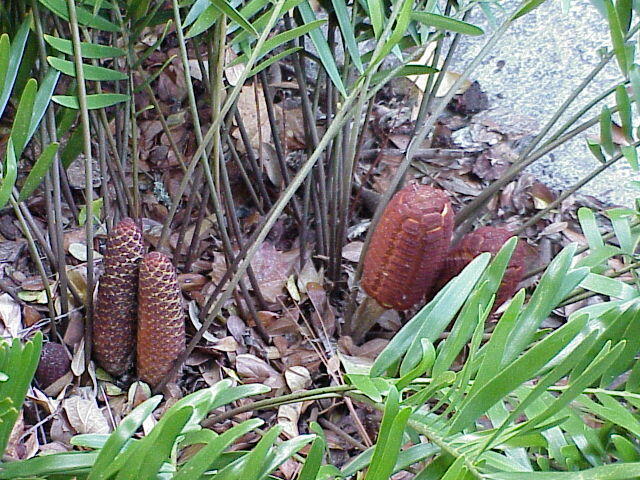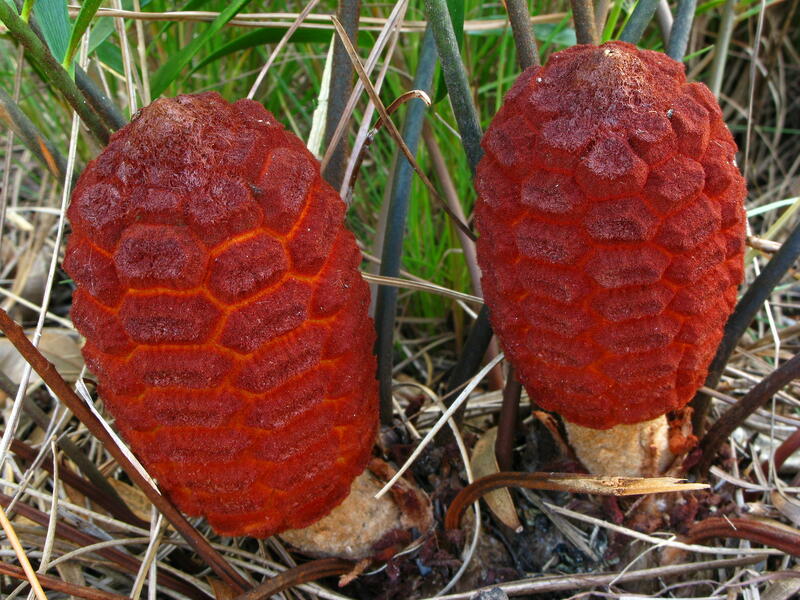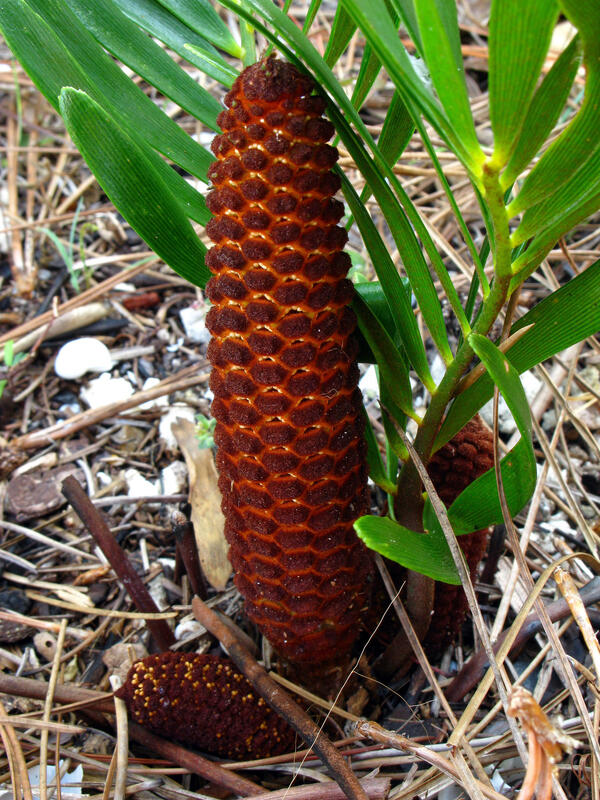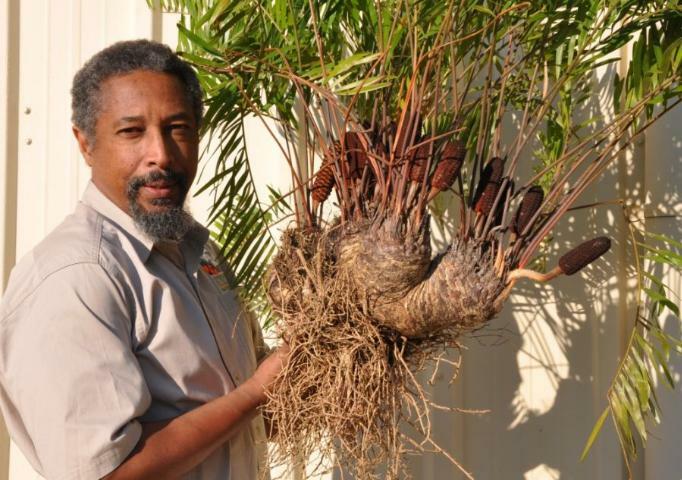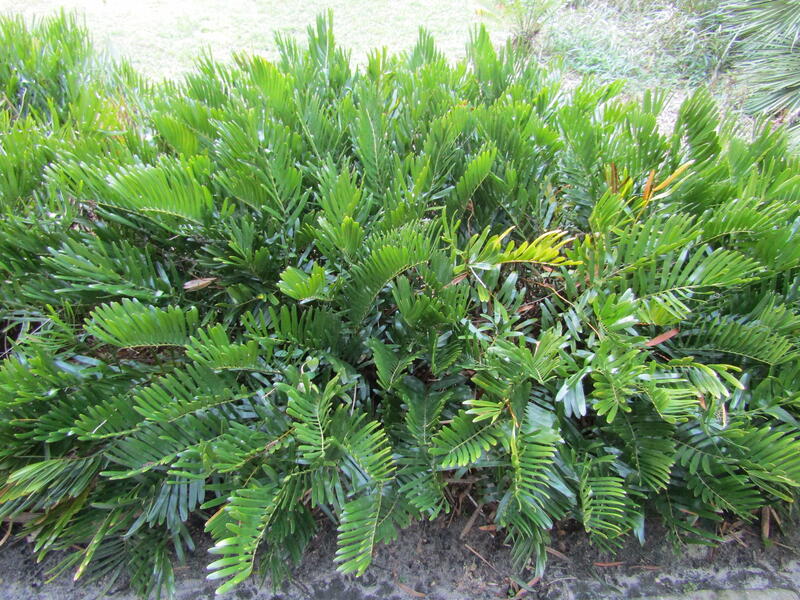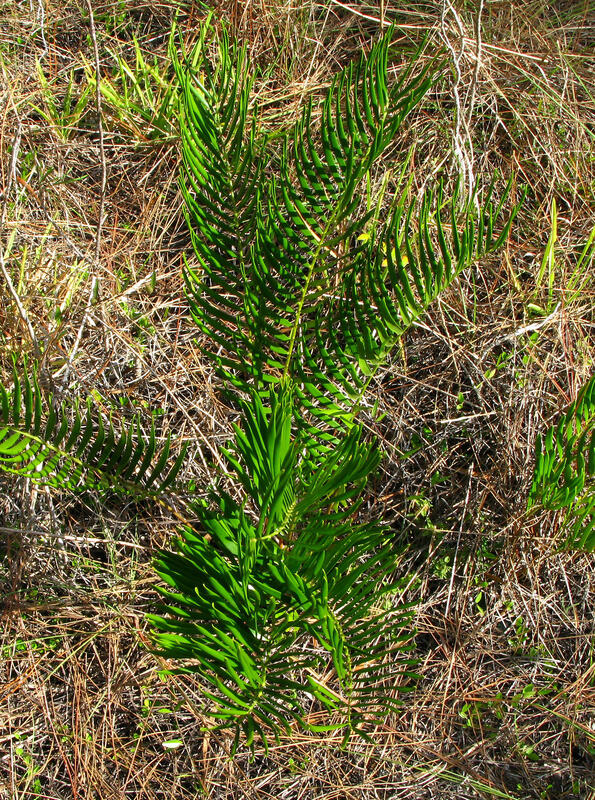







Loading profile. Please wait . . .
Zamia integrifolia var. umbrosa (Small) D.B. Ward
Florida Coontie




Federal Protection: No US federal protection
State Protection: No Georgia state protection
Global Rank: G3G4TNR
State Rank: S1
Element Locations Tracked in Biotics: Yes
SWAP 2015 Species of Greatest Conservation Need (SGCN): No
SWAP 2025 Species of Greatest Conservation Need (SGCN): Yes
2025 SGCN Priority Tier: High Conservation Concern
Element Occurrences (EOs) in Georgia: 2
Habitat Summary for element in Georgia: Maritime live oak forests
Zamia integrifolia var. umbrosa is a perennial shrub with a fern- or palm-like appearance. The stem is largely underground with only its apex usually visible aboveground, the apex woolly, covered with scales and old, hairy leaf bases. Leaves are 8 - 39 inches (20 - 100 cm) long, with 10 - 30 pairs of oblong, leathery, glossy green leaflets 2.4 - 7 inches (6 - 17 cm) long, produced in close spirals at the exposed top of the stem; the leaf stalks are spineless. Plants are dioecious, having separate female and male plants. Female plants produce a single, stout, cylindrical seed cone, 2 - 7.5 inches (5 - 19 cm) long, at the top of the stem (cones often appear to be rising directly from the ground); the seeds are covered by hexagonal, fuzzy, brownish-orange scales that are pushed apart by the seeds as they mature; the mature seeds are orange and angular. Male plants produce 2 - 5 cylindrical, reddish-brown pollen cones at the top of the stem, 2 - 6 inches (5 - 16 cm) long, covered with scales similar to the seed cone’s; pollen is released from sporangia on the undersides of the scales.
Florida Coontie is in the Cycad family. There are no other native cycads in Georgia (or the United States) and the exotic, ornamental species of cycad are not known to escape into the wild. Florida Coontie has been known by several botanical names, including Zamia pumila, Zamia floridana, and Zamia silvicola, and a number of varietal names. These entities differ largely in minor features of the leaflets and in the size of the female cones. All forms of the plant, regardless of name, are considered rare.
None in Georgia.
Maritime forests and hammocks, pine-oak woodlands, scrub, and shell mounds.
Florida Coontie has a large underground stem. The tips of the stems rise aboveground and produce new leaves in the spring or after a fire. The leaves persist for 2 - 3 years. Older plants produce underground branches, each of which produces leaves, forming a mounded patch of leaves.
In Florida, the female cones of Zamia plants are pollinated by two insects: a fungus beetle (Pharaxonotha zamiae) and a cycad weevil (Rhopalotria slossoni). The fungus beetles carry out pollination as they search for pollen on both female and male cones. They eat the pollen and feed it to their larvae. If the beetles try to eat the female cone or its seeds, they are poisoned by two glycosides, cycasin and macrozamin, and an amino acid that causes neurological lesions, all of which are concentrated in the seeds. The cycad weevil uses both female and male cones as shelter and in the process distributes pollen. Pollen is available and female cones are receptive December–March. In spite of their toxicity, the seeds are eaten by some birds and small mammals.
The toxic compounds mentioned above are also present in the underground stem, which has been used as food for thousands of years. Native Americans produced a cornstarch-like powder from the stems by heavily processing them to remove the water-soluble poisons. European settlers in Florida adopted the practice, removing many tons of the plant from the wild to make a starch called arrowroot. The starch was used in the production of Animal Crackers among other products. Collecting the plant is now illegal.
All cycads, including Zamia, fix nitrogen by way of a nitrogen-fixing cyanobacteria, Nostoc spp., that live in cycads' specialized, coralloid roots.
The plants are recognizable year round. The sex of a plant can only be determined when cones are present.
Florida Coontie is the only cycad native to the United States. It occurs in peninsular Florida and two counties in coastal Georgia.
Clearing of maritime forests, conversion of maritime hammocks and pinelands to commercial and residential development.
Zamia integrifolia var. umbrosa is ranked S1 by the Georgia Department of Natural Resources, indicating that it is critically imperiled in the state. Three populations have been documented in Georgia over the last century, only one seen in the last 20 years; it occurs on conservation land.
Protect maritime forests and hammocks from development and clearing. Conduct surveys for the species in the undeveloped portions of barrier islands.
Colorado State University. 2019. Zamia integrifolia. Guide to Poisonous Plants. James L. Voss Veterinary Teaching Hospital, Colorado State University. https://csuvth.colostate.edu/poisonous_plants/Plants/Details/124
GADNR. 2019. Element occurrence records for Zamia floridana var. umbrosa. Georgia Department of Natural Resources, Wildlife Resources Division. Social Circle, Georgia.
Godfrey, R.K. 1988. Trees, shrubs, and woody vines of northern Florida and adjacent Georgia and Alabama. University of Georgia Press, Athens.
Green, Deane. Zamia floridana: making toxins edible. Eat The Weeds. http://www.eattheweeds.com/zamia-floridana-making-toxins-edible-2/
Hammer, R. 1995. The Coontie and the Atala Hairstreak. The Palmetto, Winter, volume 15(4): 3. http://www.fnps.org/assets/pdf/palmetto/hammer_roger_l_the_coontie_and_the_atala_hairstreak_vol_15_no_4_winter_1995.pdf
Landry, G.P. 1993. Species account for Zamia integrifolia. Flora of North America North of Mexico, vol. 2. http://beta.floranorthamerica.org/Zamia_integrifolia
Lindblad, P., B. Bergman, A.V. Hofsten, L. Hallbom, J.E. Nylund. 1985. The cyanobacterium-zamia symbiosis: an ultrastructural study. New Phytologist 101(4): 707-716. https://nph.onlinelibrary.wiley.com/doi/pdf/10.1111/j.1469-8137.1985.tb02876.x
NatureServe. 2020. Species account for Zamia integrifolia. NatureServe Explorer: an online encyclopedia of life. NatureServe, Arlington, Virginia. https://explorer.natureserve.org/Taxon/ELEMENT_GLOBAL.2.155656/Zamia_integrifolia
Norstog, K.J., P.K.S. Fawcett, and A.P. Vovides. 1992. Beetle pollination of two species of Zamia: evolutionary and ecological considerations. Palaeobotanist 41: 149-158. https://www.researchgate.net/publication/261157075_Beetle_pollination_of_two_species_of_Zamia_Evolutionary_and_ecological_considerations
Weakley, A.S. 2015. Flora of the southern and mid-Atlantic States. University of North Carolina Herbarium, University of North Carolina, Chapel Hill. http://www.herbarium.unc.edu/flora.htm
Weakley, A.S., and Southeastern Flora Team. 2024. Flora of the southeastern United States Web App. University of North Carolina Herbarium, North Carolina Botanical Garden, Chapel Hill, U.S.A. https://fsus.ncbg.unc.edu/main.php?pg=show-taxon-detail.php&lsid=urn:lsid:ncbg.unc.edu:taxon:{805C7253-E977-47DB-9D42-B9039008DE29} Accessed Oct 30, 2024.
Linda G. Chafin
Linda G. Chafin, 24 April 2020: original account
